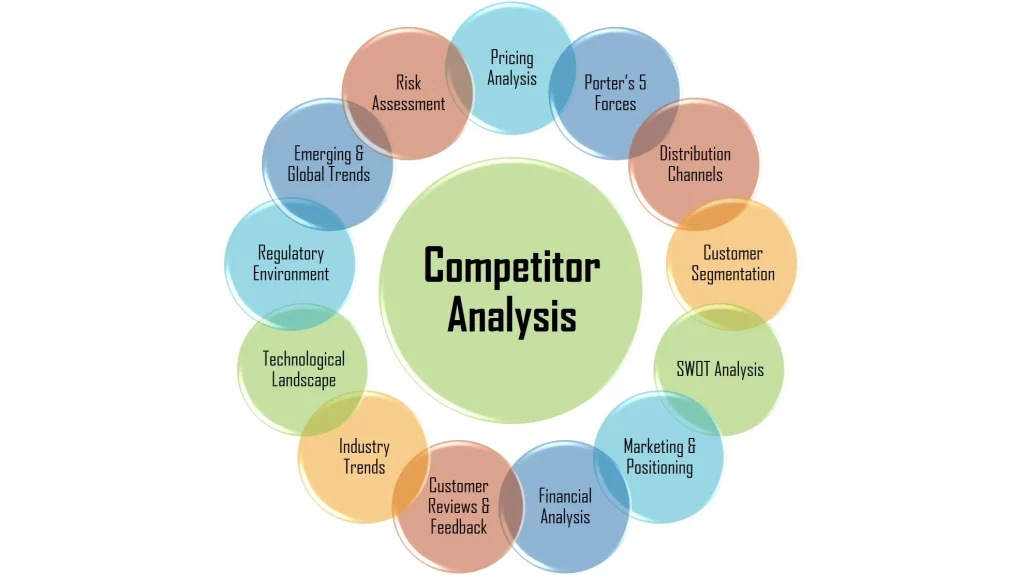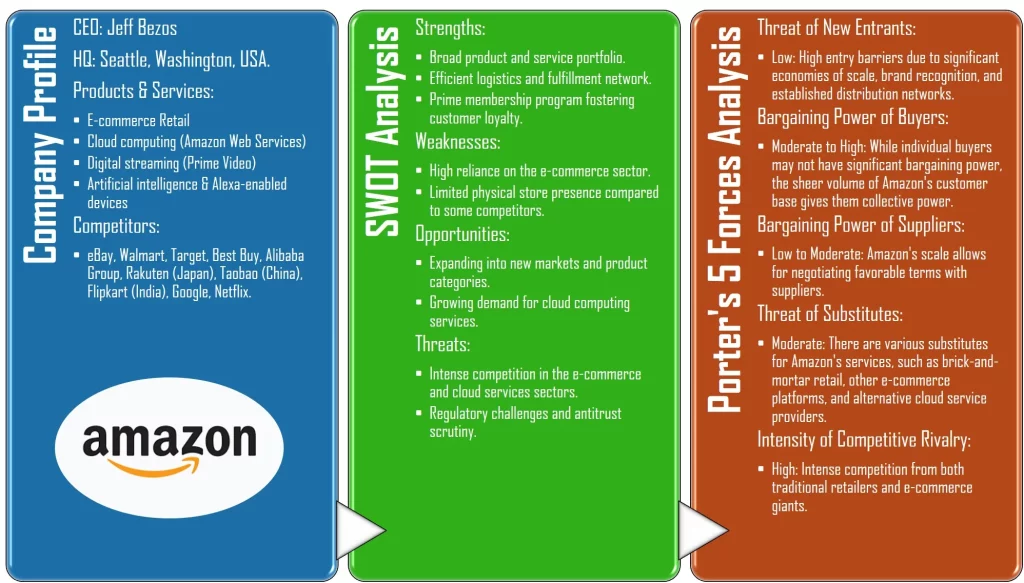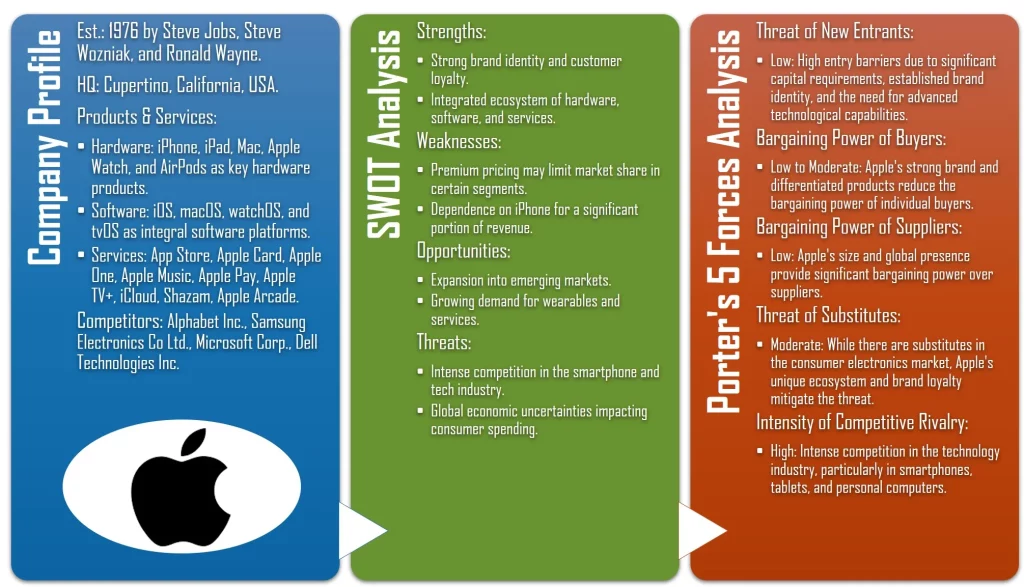
Competitor analysis is a strategic management process that involves identifying, evaluating, and understanding the strengths and weaknesses of current and potential competitors in a market. The primary goal is to gain insights into the competitive landscape to make informed business decisions and develop strategies that provide a competitive advantage.
Key Aspects to Consider:
- Identification of Competitors:
- Comprehensive Information Gathering:
- SWOT Analysis:
- Pricing Analysis:
- Market Share Analysis:
- Competitor Positioning:
- Benchmarking:
- Customer Perception:
- Customer Segmentation:
- Industry Trends:
- Technological Landscape:
- Regulatory and Legal Environment:
- Distribution Channels:
- Future Strategies:
- Financial Analysis:
- Risk Assessment:
- Global Considerations:
- Agility and Adaptability:
Competitor analysis provides valuable insights that inform strategic decision-making, allowing businesses to adapt to market changes, capitalize on opportunities, and maintain or enhance their competitive position.
Tools & Techniques
- SWOT Analysis: SWOT (Strengths, Weaknesses, Opportunities, Threats) is a basic yet effective tool for understanding a company’s internal strengths and weaknesses and external opportunities and threats. It provides a comprehensive view of the competitive landscape.
- Porter’s Five Forces: This framework helps analyze the competitive forces within an industry, including the threat of new entrants, bargaining power of buyers and suppliers, and the intensity of competitive rivalry. It aids in understanding the overall industry attractiveness.
- Competitor Profiling: Creating detailed company profiles of each competitor, including information on their products, pricing, distribution channels, marketing strategies, and financial performance.
- Benchmarking: Comparing your own performance metrics with those of competitors to identify areas of improvement and best practices.
- Market Share Analysis: Examining the market share of each competitor to understand their relative size and significance in the market.
- Customer Surveys and Feedback: Gathering information directly from customers through surveys and feedback to understand their perceptions of competitors’ products and services.
- Social Media Monitoring: Monitoring competitors’ activities and customer interactions on social media platforms to gain insights into their strategies, strengths, and weaknesses.
- Industry Reports and Publications: Utilizing industry reports, market research studies, and trade publications to gather information about market trends, competitor performance, and future industry outlook.
- Financial Analysis: Analyzing competitors’ financial statements to understand their financial health, profitability, and investment strategies.
- Competitor Intelligence Software: Using specialized software tools that automate data collection, monitoring online activities, and providing real-time updates on competitors.
- Google Alerts: Setting up Google Alerts for competitors’ names or relevant industry keywords to receive notifications about news, articles, or mentions related to them.
- Interviews and Networking: Engaging in interviews or networking events to gather informal information about competitors from industry experts, suppliers, or customers.
It’s common for businesses to use a combination of these tools to gain a holistic understanding of the competitive landscape and make informed strategic decisions. The choice of tools depends on the specific industry, market dynamics, and the information needed for analysis.
How to Conduct a Competitor Analysis
- Define the Scope and Objectives:
- Identify Competitors:
- Gather Basic Information:
- Collect Data on Products/Services:
- Competitor(s) Analysis: Depending on scope and objectives, consider:
- Document and Summarize Findings:
- Draw Conclusions and Develop Strategies:
Regularly updating and revisiting the competitor analysis is crucial as market conditions and competitors’ strategies may change over time. It’s an ongoing process that helps businesses stay agile and responsive in a dynamic business environment.
Examples
Amazon Competitor Analysis

| Competitor Analysis: Amazon Inc. | |
|---|---|
| Overview: | – Founded in 1994 by Jeff Bezos, Amazon started as an online bookstore and has since evolved into a global e-commerce and technology giant. – Headquarters: Seattle, Washington, USA. – Diverse product and service offerings, including e-commerce, cloud computing, digital streaming, and artificial intelligence. – Review this Amazon Inc. company profile. |
| Products and Services: | – Amazon offers a vast array of products and services, including e-commerce retail, Amazon Web Services (AWS), Kindle e-readers, Fire tablets, Alexa-enabled devices, Prime Video, and more. – Amazon Fresh and Whole Foods Market for grocery retail. |
| Market Presence: | – Amazon has a strong global presence, operating in multiple countries with localized websites. – Dominant in the e-commerce market with a wide range of products and fast delivery services. |
| Revenue and Financials: | – Amazon’s revenue is derived from various segments, with e-commerce, AWS, and subscription services being major contributors. – Consistent revenue growth over the years. |
| SWOT Analysis: | A. Strengths: – Broad product and service portfolio. – Efficient logistics and fulfillment network. – Prime membership program fostering customer loyalty. B. Weaknesses: – High reliance on the e-commerce sector. – Limited physical store presence compared to some competitors. C. Opportunities: – Expanding into new markets and product categories. – Growing demand for cloud computing services. D. Threats: – Intense competition in the e-commerce and cloud services sectors. – Regulatory challenges and antitrust scrutiny. |
| Porter’s 5 Forces Analysis: | A. Threat of New Entrants: – Low: High entry barriers due to significant economies of scale, brand recognition, and established distribution networks. – Amazon’s massive infrastructure investments and global reach create a challenging environment for new entrants. B. Bargaining Power of Buyers: – Moderate to High: While individual buyers may not have significant bargaining power, the sheer volume of Amazon’s customer base gives them collective power. – Amazon’s customer-centric approach and Prime membership program help foster loyalty and mitigate buyer power. C. Bargaining Power of Suppliers: – Low to Moderate: Amazon’s scale allows for negotiating favorable terms with suppliers. – However, in certain segments like publishing or AWS, where suppliers may have unique products or services, supplier power could be moderate. D. Threat of Substitutes: – Moderate: There are various substitutes for Amazon’s services, such as brick-and-mortar retail, other e-commerce platforms, and alternative cloud service providers. – Prime membership benefits, extensive product range, and customer loyalty efforts help mitigate the threat. E. Intensity of Competitive Rivalry: – High: Intense competition from both traditional retailers and e-commerce giants. – Continuous innovation, aggressive pricing strategies, and a focus on customer experience are essential for Amazon to maintain a competitive edge. |
| Competitive Landscape: | A. Direct Competitors: – Walmart: Competes in both e-commerce and brick-and-mortar retail. – Alibaba: Major e-commerce player with a strong presence in China. B. Indirect Competitors: – Google: Competing in cloud services, digital content, and voice-activated devices. – Netflix: Competing in the streaming services market. |
| Pricing Strategy: | – Amazon employs a dynamic pricing strategy, utilizing algorithms to adjust prices based on demand, competition, and other factors. – Prime membership offers various benefits, including free shipping and access to streaming services. |
| Customer Focus: | – Customer-centric approach with a focus on convenience, competitive pricing, and a seamless shopping experience. – Investments in technology, such as machine learning, to enhance personalization. |
| Innovation and Technology: | – Pioneering innovations like one-click shopping, Amazon Echo, and Alexa. – Significant investment in robotics for warehouse automation. |
| Logistics and Fulfillment: | – Efficient supply chain and fulfillment network, including Amazon Prime for fast and reliable deliveries. – Investment in last-mile delivery options, such as Amazon Flex. |
| Strategic Acquisitions: | – Acquisition of Whole Foods Market in 2017 for a significant entry into the grocery retail sector. – Purchase of Ring, a smart home security company, and PillPack, an online pharmacy, to expand product offerings. |
| Social Responsibility: | – Commitment to sustainability and environmental initiatives, such as The Climate Pledge. – Employment of a large workforce globally, but also facing scrutiny for labor practices. |
| Challenges: | – Facing regulatory scrutiny regarding antitrust concerns due to its market dominance. – Potential challenges from competitors diversifying their services and entering Amazon’s core markets. |
| Conclusions: | A. Market Dominance and Diversification: – Amazon’s broad product and service portfolio, efficient logistics, and strong brand loyalty contribute to its market dominance. – Diversification into various sectors, including e-commerce, cloud computing, and digital content, has been a key strength. B. Customer-Centric Approach: – Amazon’s success is closely tied to its customer-centric approach, emphasizing convenience, competitive pricing, and a seamless shopping experience. C. Innovation and Technology Leadership: – Amazon’s focus on innovation and technology, evident in initiatives like Prime, Alexa, and warehouse automation, positions it as a technology leader. D. Challenges and Regulatory Scrutiny: – Amazon faces challenges from regulatory scrutiny and antitrust concerns due to its market dominance. – Labor practices and treatment of employees have also come under scrutiny. E. Competitive Landscape: – Direct competitors include Walmart and Alibaba, while indirect competitors such as Google and Netflix compete in various sectors. – The competitive landscape is dynamic, with competitors diversifying their services and entering Amazon’s core markets. |
| Strategies: | A. Continue Diversification: – Explore new markets and product categories to reduce reliance on the e-commerce sector. – Leverage acquisitions and partnerships to strengthen presence in emerging industries. B. Enhance Customer Experience: – Further invest in technology and personalization to enhance the overall customer experience. – Innovate in areas such as augmented reality for virtual shopping experiences. C. Address Regulatory Concerns: – Proactively address antitrust concerns by collaborating with regulatory bodies and implementing transparent business practices. – Enhance corporate social responsibility initiatives to address labor-related criticisms. D. Sustainability and Environmental Initiatives: – Continue and expand efforts towards sustainability, building on initiatives like The Climate Pledge. – Communicate and promote these initiatives to align with growing consumer preferences for eco-friendly practices. E. Competitive Response: – Stay vigilant and responsive to competitors’ moves, especially in the areas of e-commerce, cloud services, and digital content. – Consider strategic alliances or partnerships to counteract competitive threats. F. Global Expansion and Local Adaptation: – Expand global operations, focusing on markets with high growth potential. – Tailor strategies to local markets, considering cultural nuances and preferences. G. Invest in Workforce and Employee Satisfaction: – Address concerns related to labor practices by investing in employee welfare, training, and career development. – Enhance employee satisfaction to mitigate negative perceptions and attract top talent. H. Strategic Marketing and Branding: – Continue strategic marketing efforts to maintain and strengthen brand loyalty. – Emphasize unique selling propositions and differentiators in marketing campaigns. I. Adapt to Technological Trends: – Stay at the forefront of technological trends, investing in emerging technologies like artificial intelligence, virtual reality, and blockchain. – Continuously innovate to maintain a competitive edge in the rapidly evolving tech landscape. |
Apple Inc. Competitor Analysis

| Competitor Analysis: Apple Inc. | |
|---|---|
| Overview: | – Founded in 1976 by Steve Jobs, Steve Wozniak, and Ronald Wayne. – Headquarters: Cupertino, California, USA. – A leading technology company known for its consumer electronics, software, and services. – Review this Apple Company Profile. |
| Products and Services: | – Iconic product line, including iPhone, iPad, Mac, Apple Watch, and AirPods. – Software services, such as iOS, macOS, App Store, iTunes, Apple Music, and iCloud. |
| Market Presence: | – Globally recognized brand with a strong presence in various markets. – Apple stores and authorized resellers for physical retail. |
| Revenue and Financials: | – Diverse revenue streams, primarily from iPhone sales, followed by services, Mac, iPad, and wearables. – Consistent financial performance and high-profit margins. |
| SWOT Analysis: | A. Strengths: – Strong brand identity and customer loyalty. – Integrated ecosystem of hardware, software, and services. B. Weaknesses: – Premium pricing may limit market share in certain segments. – Dependence on iPhone for a significant portion of revenue. C. Opportunities: – Expansion into emerging markets. – Growing demand for wearables and services. D. Threats: – Intense competition in the smartphone and tech industry. – Global economic uncertainties impacting consumer spending. – Here is a sample Apple Inc. SWOT analysis. |
| Porter’s 5 Forces Analysis: | A. Threat of New Entrants: – Low: High entry barriers due to significant capital requirements, established brand identity, and the need for advanced technological capabilities. – Apple’s strong brand and customer loyalty act as deterrents for new entrants. B. Bargaining Power of Buyers: – Low to Moderate: Apple’s strong brand and differentiated products reduce the bargaining power of individual buyers. – However, the availability of alternative products and competition in the market can moderate buyer power. C. Bargaining Power of Suppliers: – Low: Apple’s size and global presence provide significant bargaining power over suppliers. – Strategic supplier relationships are maintained, and Apple’s scale allows for favorable terms. D. Threat of Substitutes: – Moderate: While there are substitutes in the consumer electronics market, Apple’s unique ecosystem and brand loyalty mitigate the threat. – Android-based devices, Windows PCs, and other alternatives pose a moderate threat. E. Intensity of Competitive Rivalry: – High: Intense competition in the technology industry, particularly in smartphones, tablets, and personal computers. – Competitors like Samsung, Google, Microsoft, and Amazon offer alternatives and innovations. |
| Competitive Landscape: | A. Direct Competitors: – Samsung: Competes in smartphones, consumer electronics, and semiconductor manufacturing. – Google: Competes in smartphones, software (Android), and cloud services. B. Indirect Competitors: – Microsoft: Competing in personal computing, software, and cloud services. – Amazon: Competing in consumer electronics, cloud services, and digital content. |
| Pricing Strategy: | -Premium pricing strategy emphasizing product quality and innovation. -Higher profit margins compared to competitors due to brand perception. |
| Customer Focus: | – Focus on delivering an exceptional user experience. – High emphasis on design, functionality, and customer satisfaction. |
| Innovation and Technology: | – Consistent focus on innovation, evidenced by product launches and updates. – Investments in research and development for cutting-edge technologies. |
| Ecosystem Integration: | – Seamless integration between Apple devices and services. – iCloud for synchronized data and content across devices. |
| Retail Strategy: | – Apple Retail Stores for direct customer engagement and product experience. – Online store for global reach and sales. |
| Supply Chain Management: | – Tight control over the supply chain for quality assurance and production efficiency. – Key supplier relationships for components like processors and displays. |
| Environmental Sustainability: | – Commitment to environmental responsibility, with initiatives like recycling programs and the use of renewable energy in manufacturing. |
| Legal and Intellectual Property: | – Active in protecting intellectual property through patents and legal actions. – Occasionally involved in legal disputes, such as patent infringement cases. |
| Challenges: | – Dependency on iPhone sales for a significant portion of revenue. – Balancing innovation with maintaining compatibility within the existing ecosystem. |
| Conclusions: | – Apple’s competitor analysis reveals the company’s significant strengths, such as a strong brand, customer loyalty, and an integrated ecosystem. – However, challenges like dependence on iPhone sales and the need for continuous innovation are apparent. – The competitive landscape poses threats from intense rivalry and potential substitutes, emphasizing the dynamic nature of the technology industry. |
| Strategies: | A. Innovation Leadership: – Continue to invest heavily in research and development to maintain a leadership position in innovation. – Launch new, groundbreaking products to stay ahead of competitors. B. Ecosystem Integration: – Strengthen the seamless integration between Apple devices and services to enhance the overall customer experience. – Leverage the ecosystem to encourage cross-product usage and increase customer loyalty. C. Diversification: – Explore opportunities for diversification into emerging markets and product categories. – Decrease dependency on iPhone sales by expanding the product and services portfolio. D. Global Expansion: – Continue expanding into emerging markets to tap into new customer bases. – Tailor products and services to meet the specific needs and preferences of diverse global markets. E. Customer Retention: – Maintain a strong focus on customer satisfaction and after-sales service. – Leverage Apple’s strong brand to enhance customer loyalty and retention. F. Sustainability Initiatives: – Strengthen commitment to environmental sustainability, aligning with consumer values. – Implement and communicate eco-friendly practices across the supply chain. G. Strategic Partnerships: – Form strategic partnerships to enhance product offerings and expand services. – Collaborate with other industry leaders to create synergies and improve market competitiveness. H. Addressing iPhone Dependency: – Develop strategies to reduce dependence on iPhone sales by promoting growth in other product categories, such as wearables and services. – Explore opportunities in emerging technologies. I. Market Education: – Educate the market on the unique benefits of the Apple ecosystem. – Communicate the value proposition to consumers, emphasizing security, privacy, and a seamless user experience. J. Agile Responses to Market Changes: – Stay agile and responsive to changes in consumer preferences, technological advancements, and regulatory landscapes. – Continuously monitor the competitive landscape for emerging threats and opportunities. |
In conclusion, the key to a successful competitor analysis involves thorough identification of competitors, comprehensive data collection on various aspects of their business, application of analytical tools like SWOT and Porter’s Five Forces, and understanding competitors’ market positioning. Regular updates and a strategic approach are essential to staying informed and gaining a competitive edge.
